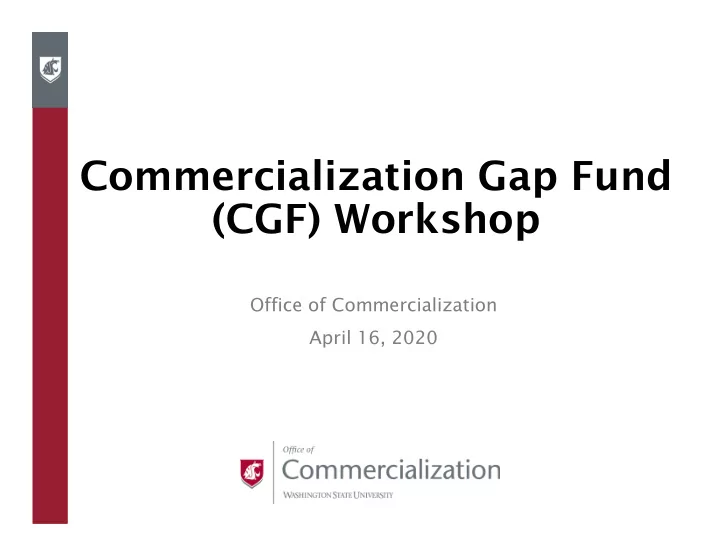

Commercialization Gap Fund (CGF) Workshop Office of Commercialization April 16, 2020
What is a Gap Fund? • Funding opportunity to bridge the “gap” between your research and commercialization • Helps transfer research to the market place • Helps promote entrepreneurship on campus • Funds are available to • Clarify market needs • Refine a value GAP FUND proposition • Decrease technical risk through prototyping • Not a federal grant
WSU Commercialization Gap Fund (CGF) • Program re-established in 2014 with the support from the WSU Offices of the President, Provost, and Vice President of Research • Generous donation from Washington Research Foundation (WRF) • Matching funds from the Office of Commercialization (OC), unit within the Office of Research (OR) • Proposal cycle is July–December • Project cycle is January–December of the following year • Each project is awarded up to $40,000
Eligibility • WSU Affiliation – Faculty, Graduate Students, Staff • A faculty member must be named as the Principal Investigator (PI) on the project • WSU Inventions that have been disclosed to the Office of Commercialization (OC) at least 2 months prior to the Letter of Intent (LOI) date • Basic research projects are not eligible • If in doubt, contact the Office of Commercialization (commercialization@wsu.edu)
How does the Commercialization Gap Fund (CGF) help? • In developing prototypes • Building device • Minimum viable product (MVP) • Proof of concept • Concrete validation • Must be more than proving a hypothesis • Validation • Toxicology tests • Scale up manufacturing • For Business development • Attending tradeshows • Gaining customer feedback
Office of Commercialization Involvement • Evaluate if the technology qualifies for the funding program • Review proposal forms before submission • Letter of Intent • Pre-proposal • Full proposal • Assist with budget related questions • Guide in preparing the pitch presentation • OC leverages Entrepreneurs in Residence (EIR) network to help advise researchers on proposals Please note: OC staff are not involved in the committee review process or award decisions
CGF Proposal Process • Invention disclosure completed • Letter of Intent submission (7/24/2020) • Pre-proposal submissions (9/18/2020) Internal Committee Review Invitations for full proposals • Full Proposal submission (11/2/2020) • Pitch Presentation (week of 11/9/2020) • Award Announcements (week of 12/7/2020) • Milestone Distributions + Milestone Reports (January – December 2021)
https://commercialization.wsu.edu/cgf-guide/
Pre-Proposal
Pre-Proposal
Pre-Proposal
Pre-Proposal
Pre-Proposal
Pre-Proposal
Pre-Proposal
Pre-Proposal
Pre-Proposal
Full Proposal Documents Application Executive Summary
Full proposal pitch presentation • Slide 1: Introduction • Slide 2: Description of the Problem • Slide 3: Solution (benefits) • Slide 4: Traction • Slides 5-6: Market Size and Customers • Slide 7: Market Plan • Slide 8: Competition • Slide 9: Team
Splatt Table—Selected Slides
Drywall Waste Blocks (DWB) turn low-value waste into cost-effective, high-performance building materials.
DWB is an environmental & economic solution. • Potential to remove 9.7 Million tons of waste yearly from US landfills. • Cost-effective, high-performance product. • New markets for waste recyclers. • Lower disposal costs for waste producers.
DWB Traction • Advanced prototype stage. • Patent-pending with broad claims. • Contacts made with interested companies. • Featured in multiple trade publications. • Minimum viable product & proof-of-concept manufacturing achieved. • Technical gaps remain for structural use. • CGF-funded milestones will close gaps & prove structural viability.
DWB Competitive Advantages • Up to 2X lighter & 10X insulation value of a typical Concrete Masonry Unit (CMU) @ same price point. • Lower cost than specialty (lightweight) CMU. • Exclusive recycling method for drywall demo waste. • Made on industry-standard machines = low barrier to entry for established CMU manufacturers. • Waste processing requirements less expensive than current methods.
RECOVERING VALUABLE BIOACTIVE COMPOUNDS FROM POTATO PEELS WITH SEQUENTIAL HYDROTHERMAL EXTRACTION
A VISIT FROM POTATO PROCESSORS
GAP Fund Milestones Continuous-flow system Batch system Provide the performance assessment and industrially useful and scalable process configuration. Collect essential engineering data to further optimize the system, and to support its scale-up. Develop a comprehensive TEA, and determine optimal process conditions based on target products, costs and environmental concerns.
AAVogen: A novel therapeutic for treating skeletal and cardiac muscle wasting MUSCLE WASTING Muscular Dystrophy Cancer Cachexia Number of patients suffering from muscle wasting: 70 million Cost: $550 billion/year No therapeutic available
AAVogen: A novel therapeutic for treating skeletal and cardiac muscle wasting THE SOLUTION AAV-based gene therapy increases muscle mass Disclosure to OC: April 2015 Provisional Patent Filed: April 2015 CGF Funds: January 2016 Science Translational Medicine publication • Business Plan Developed – AAVogen is born! • International Patent Filings: April 2016 •
AAVogen: A novel therapeutic for treating skeletal and cardiac muscle wasting • 2017: Awarded NIH/NCI Phase II SBIR ($2M) • Publications in Human Gene Therapy (2018) and American Journal of Physiology (2019) • 2018: FDA Pre-IND Meeting • 2019: Awarded a Phase I SBIR ($225K) Screen Shot 2018-04-05 at 9.19.04 AM AAVogen: Stronger than ever!!
Tips and Tricks to create a successful proposal • Prepare pre-proposal ahead of time • Identify as many potential customers as possible • Provide detailed distribution of the funding needed for the project
Innovation Corps (I-Corps) Program • Developed by National Science Foundation (NSF) in 2011 • Helps transition academic research to the marketplace • Teams funded up to $2500 for • Prototype development • Attending conferences • Other needs related to refining the team’s business model • Two cohorts each year: • Fall – September to October • Spring – January to March Learn more: https://research.wsu.edu/icorps/about/
OC Homepage: https://commercialization.wsu.edu/
FY20 Deadlines • Letter of Intent – July 24, 2020 • Preproposal – September 18, 2020 • Internal Review – September 23, 2020 – October 7, 2020 • Full Proposal – November 2, 2020 • Slides Due – November 6, 2020 • Presentation – Week of November 9, 2020 https://commercialization.wsu.edu/commercialization-gap-fund/
Recommend
More recommend